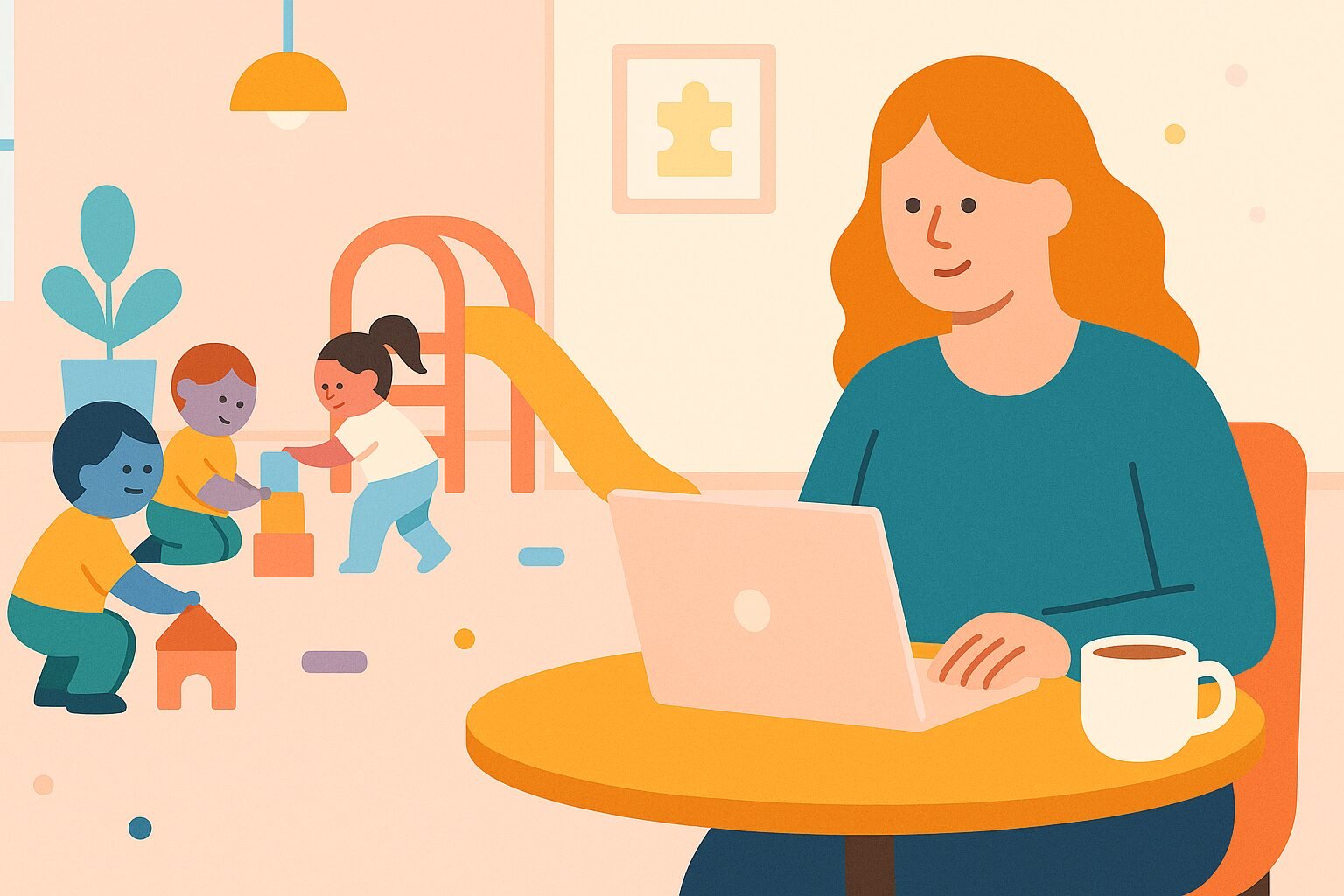Play cafés have become one of the most exciting small business ideas of the past decade. They bring together two things parents want most: a safe, engaging space for children and a comfortable place for adults to relax, work, or connect with others. If you’ve ever visited one and thought, “I could create something like this in my community,” you’re not alone. Many entrepreneurs are exploring the play café business model as both a passion project and a profitable venture.
But opening a play café isn’t as simple as finding a space and buying some toys. Like any business, it requires careful planning, realistic budgeting, and a clear understanding of your audience. This article walks through the key things to consider if you’re serious about starting a play café; from concept and location to finances, marketing, and daily operations.
Why Start a Play Café?
There’s a growing market for family-friendly spaces that go beyond the typical playground or coffee shop. Parents are increasingly working remotely, homeschooling is on the rise, and community hubs are more valuable than ever. A well-designed play café taps into these needs by offering:
- Activities for kids: Safe, clean, and engaging play structures, toys, or activity zones.
- Spaces for toddlers: Dedicated areas for younger children where parents feel secure.
- Café atmosphere: Coffee, tea, snacks, and meals that appeal to adults as much as kids.
- Community value: A gathering place for playdates, birthday parties, and group events.
Unlike large entertainment centers or arcade chains, play cafés are often more intimate and design-forward. They appeal to millennial and Gen Z parents who value both experience and quality. For entrepreneurs, this makes the model especially attractive: you’re not competing directly with huge franchises but carving out a niche that blends hospitality and recreation.
Step 1: Clarify Your Concept
No two play cafés look exactly the same. Some lean heavily into the café side with barista-quality drinks and a stylish menu, while others emphasize elaborate play structures. Before you write a single page of a business plan, ask yourself:
- Do you want a boutique, design-driven space, or a larger, more activity-focused venue?
- Will your café serve full meals, or keep it simple with coffee and snacks?
- What age groups will you focus on: infants, toddlers, preschoolers, or a mix?
- Will you offer extras like classes, memberships, or private party bookings?
Your answers shape everything else, from your location requirements to your staffing needs. A smaller neighborhood café with Montessori-inspired play zones looks very different from a suburban space with a full climbing gym and café kitchen.
Step 2: Understand Your Market
Play cafés succeed when they’re located where parents already are: near schools, daycare centers, neighborhoods with young families, or walkable urban districts. Spend time researching your local market:
- Demographics: How many families with children under age 6 live in the area?
- Competition: Are there other indoor play spaces, coffee shops, or family centers nearby? What are they doing well, and where do they fall short?
- Demand: Talk to parents directly. What are they missing? A clean indoor toddler space? Better coffee? A place to host parties?
A play café is hyperlocal by nature. Even if the idea excites you, success depends on whether your neighborhood has enough of the right families to support it.
Step 3: Outline Your Revenue Streams
Most play cafés earn money in several ways. Thinking through this early helps you plan for sustainability:
- Entry fees: Charging per visit or per hour for play.
- Café sales: Coffee, tea, smoothies, baked goods, or even light meals.
- Memberships: Monthly or annual passes that guarantee steady income.
- Parties and rentals: Birthday parties, private events, or group bookings.
- Classes or workshops: Music, art, or storytime sessions can attract repeat visitors.
The most successful cafés usually combine several of these. Relying only on coffee sales or only on play entry fees makes it harder to balance expenses.
Step 4: Estimate Your Startup Costs
One of the biggest surprises for new owners is how expensive it can be to open a play café. Costs vary widely depending on size and location, but here are the main categories to expect:
- Leasehold improvements (renovating your space).
- Play equipment (soft play zones, climbing structures, toys, furniture).
- Café equipment (espresso machine, refrigerators, seating).
- Licensing and insurance.
- Staff hiring and training.
- Marketing and branding.
Depending on your vision, startup costs can range from $150,000 for a small space with minimal equipment to $500,000+ for a larger, fully built-out café. Investors will want to see that you’ve researched these numbers carefully.
Step 5: Draft a Business Plan
A business plan isn’t just for banks or investors—it’s for you. Writing one forces you to clarify your goals, outline your financials, and anticipate challenges. Your plan should cover:
- Executive summary (what your café is and why it matters).
- Market analysis (who you’re serving, and why there’s demand).
- Operations (how you’ll run the café day to day).
- Revenue projections and funding needs.
- Marketing strategy.
Even if you never show it to anyone else, the process of creating this document helps you avoid costly mistakes. Consider it your roadmap. Here’s a handy guide and template for writing a play cafe business plan by Ivan Smith in Medium.
Free Startup Checklist
Planning a play café is exciting, but it’s easy to miss key steps along the way.
That’s why we created a one-page Play Café Startup Checklist you can print and use to track your progress.
It covers everything from concept planning to your grand opening.
📥 Download the Checklist (PDF)
Step 6: Create a Marketing Strategy
Parents today find play cafés through online search and word of mouth. That means your marketing needs to hit both:
- Digital presence: Build a professional website, optimize for search terms like “play café near me,” and keep your directory listing updated.
- Social media: Instagram and Facebook are especially powerful. Post photos of your space, highlight upcoming events, and engage with local parent groups.
- Community outreach: Partner with schools, pediatricians, and local businesses. Offer free passes for new parents or discounts for group visits.
Don’t underestimate design. Parents are often drawn to spaces that look inviting online before they ever step through the door.
Step 7: Plan for Operations and Staffing
Running a play café involves more than pulling espresso shots. You’ll need to think about:
- Safety and cleanliness: Daily cleaning schedules, staff training, and child-safe materials.
- Staffing: Baristas, play attendants, and managers who can multitask and handle both kids and parents.
- Scheduling: Balancing open play, private parties, and special events.
- Policies: Clear rules for age limits, food allergies, and supervision responsibilities.
The best play cafés feel effortless to visitors because the behind-the-scenes systems are so well thought out.
Step 8: Anticipate Challenges
Every business comes with risks. For play cafés, common challenges include:
- High overhead: Rent and staff costs can be significant.
- Seasonality: Busy in winter or rainy months, slower in good weather.
- Safety concerns: Parents won’t return if they feel the space is unsafe or unclean.
- Balancing roles: You’re running both a café and a play space, which means juggling two different businesses in one.
Thinking about these issues upfront and building solutions into your plan will help you stand out.
Step 9: Build Community from Day One
What makes a play café special isn’t just the equipment; it’s the relationships. Encourage parents to see your café as their “third place” (not home, not work, but a community hub). Ideas include:
- Hosting parent meetups or homeschool groups.
- Offering loyalty programs or memberships.
- Partnering with local artisans or food vendors to keep your café menu fresh.
- Highlighting customer stories on your website and social media.
Community-building makes your business stickier and less vulnerable to competition.
Conclusion
Starting a play café is both exciting and demanding. It blends hospitality, childcare considerations, and community-building in ways that few other businesses do. If you’re passionate about creating activities for kids and comfortable spaces for toddlers, it can also be deeply rewarding.
The journey begins with clarity: understanding your concept, your market, and your financial needs. From there, a thoughtful business plan and strong marketing strategy can turn your idea into reality. Explore our About Us page to learn why we started Find A Play Café, or browse our directory to see examples of cafés already making an impact. With preparation and persistence, your dream of opening a play café can become more than an idea; it can become the heart of a community.



